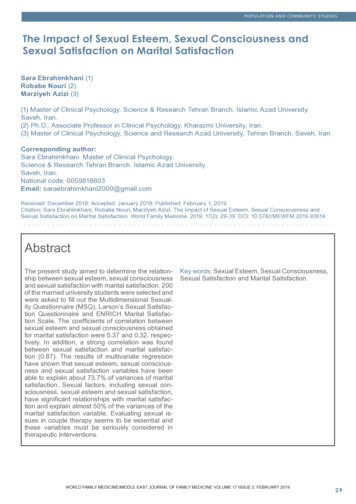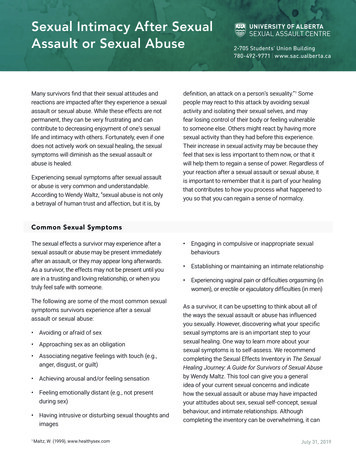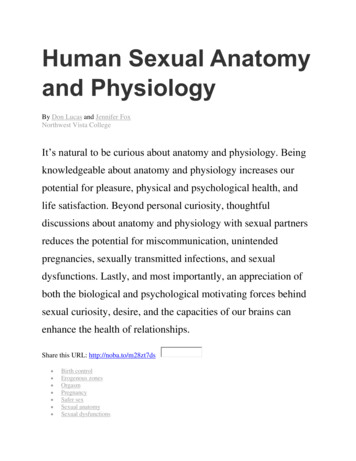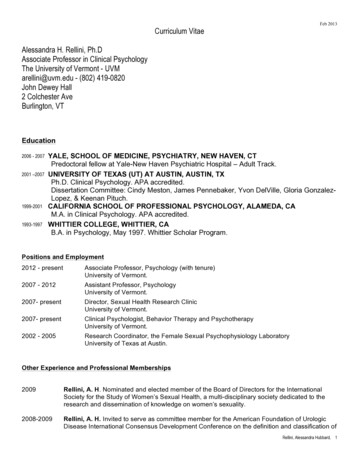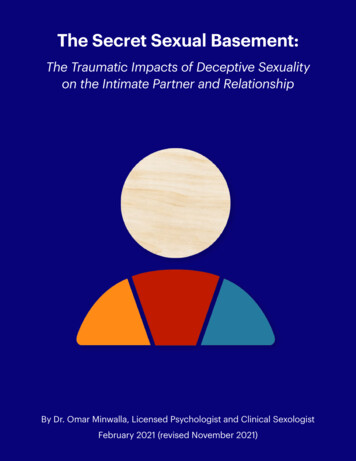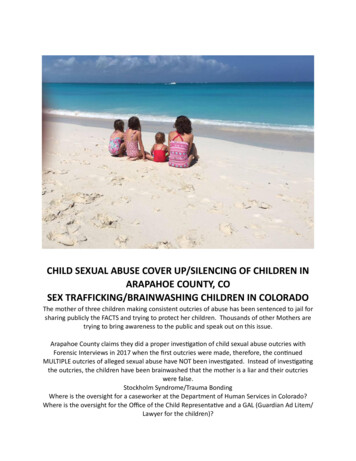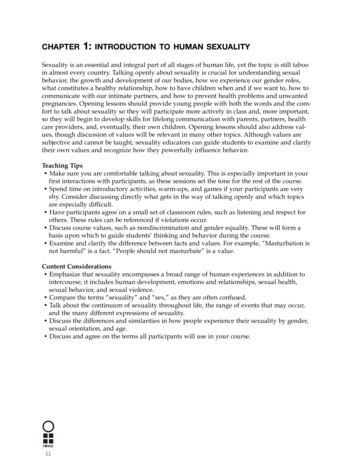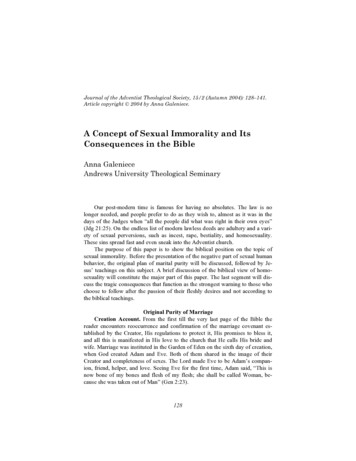
Transcription
Journal of the Adventist Theological Society, 15/2 (Autumn 2004): 128–141.Article copyright 2004 by Anna Galeniece.A Concept of Sexual Immorality and ItsConsequences in the BibleAnna GalenieceAndrews University Theological SeminaryOur post-modern time is famous for having no absolutes. The law is nolonger needed, and people prefer to do as they wish to, almost as it was in thedays of the Judges when “all the people did what was right in their own eyes”(Jdg 21:25). On the endless list of modern lawless deeds are adultery and a variety of sexual perversions, such as incest, rape, bestiality, and homosexuality.These sins spread fast and even sneak into the Adventist church.The purpose of this paper is to show the biblical position on the topic ofsexual immorality. Before the presentation of the negative part of sexual humanbehavior, the original plan of marital purity will be discussed, followed by Jesus’ teachings on this subject. A brief discussion of the biblical view of homosexuality will constitute the major part of this paper. The last segment will discuss the tragic consequences that function as the strongest warning to those whochoose to follow after the passion of their fleshly desires and not according tothe biblical teachings.Original Purity of MarriageCreation Account. From the first till the very last page of the Bible thereader encounters reoccurrence and confirmation of the marriage covenant established by the Creator, His regulations to protect it, His promises to bless it,and all this is manifested in His love to the church that He calls His bride andwife. Marriage was instituted in the Garden of Eden on the sixth day of creation,when God created Adam and Eve. Both of them shared in the image of theirCreator and completeness of sexes. The Lord made Eve to be Adam’s companion, friend, helper, and love. Seeing Eve for the first time, Adam said, “This isnow bone of my bones and flesh of my flesh; she shall be called Woman, because she was taken out of Man” (Gen 2:23).128
GALENIECE: A CONCEPT OF SEXUAL IMMORALITYThe Hebrew words for “man” and “woman” are ’iš and ’iššah or “husband”and “wife,” respectively. It should be noted that the assonance of ’iš/’iššah focuses the reader’s attention on both the differentiation of functions and the oneness of man-and-woman. Adam “cleaved” to his ’iššah. He entered into lastingcommunity of life with Eve because of his love for her. This means much morethan just socializing with her; he engaged in “very personal concern, fidelity andinvolvement.”1 This unity of two human beings of “sexual gratification finds itslegitimate expression only within the confines of marriage.”2It is important to note here that human beings were created in the image ofGod and united in His love. The Creation account presents the model of the family as a unit of two loving people of opposite sex mutually united by covenantsand promises under God, when both a husband and a wife willingly leave alltheir old friends, even parents, “and they shall become one flesh” (Gen 2:24).Biblically based marriage is more than a contract between two adults who agreeto share their lives under certain conditions. A marriage is used as an “earthlypicture of the divine love. Marriage is a reminder of God as the One who loves.More specifically it presents the exclusive nature of the divine love.”3Another important aspect of marriage has a procreation note. In the Gardenof Eden the Lord not only blessed ’iš and ’iššah, but He also gave them a powerto reproduce themselves. He said, "Be fruitful and multiply” (Gen 1:28).Be Holy for I Am Holy. Biblically based purity of marriage is rooted in thevery Decalogue. The Lord Himself pronounced, “You shall not commit adultery” (Exod 20:14). This commandment not only prevents from adultery, butalso from all kinds of sexually transmitted diseases. The Lord wants His earthlychildren to enjoy the original purity of their sacred union of marital relationship.In the next book of the Bible, Leviticus, the reader finds numerous times thefollowing expression, “Be holy, because I am holy” (Lev 11:44). In this andother verses God calls humans to holiness, but this holiness is not their own holiness. God’s holiness requires a total separation from all forms of sin, includingadultery. At the same time, He who created humans knows that they can’t beholy in their own power. Therefore, the Lord “who has begun a good work inyou will complete it until the day of Jesus Christ” (Phil 1:6).Holiness of God also calls humans to the higher standards of God’s perfection. It requires a separation from all things, whatever they might be, to God,who has superior plans for human beings and their marriage relationships. As1234.Claus Westermann, Genesis 1-11: A Continental Commentary (Minneapolis: Fortress, 1994),2Calvin B. Rock, “Marriage and Family,” in Handbook of Seventh-day Adventist Theology(Hagerstown: Review and Herald, 2000), 726.3Stanley J. Grenz, “Theological Foundations for Male-Female Relationships,” JETS 41/4(1998): 623.129
JOURNAL OF THE ADVENTIST THEOLOGICAL SOCIETYBruce Wilkinson states, “Holiness is the center of God’s will for you.”4 Thus,holiness requires submissiveness to God’s will, His “good, pleasing and perfectwill” (Rom 12:2), known from His commandments and revelations.Jesus’ Teachings. The Savior of the world, who is also its Creator, has notchanged with the time. He taught the people the same truth about marital purityas He did at the creation and on Mount Sinai. Knowing sinfulness was leadinghumans to their own destruction, Jesus reminded them in Matthew 5 about thespirit of the law. In His antithesis You have heard . . . But I tell you “Jesus doesnot contradict what was said but brings it into sharper ethical focus. Hill calls it‘a radical intensification of the demands of the law’ (p. 119).”5According to Jesus in Matthew 19:6, “So then, they are no longer two butone flesh. Therefore what God has joined together, let not man separate.” Marriage as a faithful unity is a principle that shelters “the couple from outside attacks, and from frivolity, capriciousness, and unfaithfulness within the marriage(Ex 20:14). The Christian enters this covenant with total devotion, pledging hisor her utmost to love and cherish, in sickness and in health.”6It is very important to note here that a loving devotion of a husband and awife to each other has nothing to do with the supremacy of one party and thefearful dependency of the other party. Godly relationship involves both sexualparties in the unity of their marriage to present their unique perspectives as loving gifts to each other. Paul declares that in the Lord, “neither is man independent of woman, nor woman independent of man” (1 Cor 11:11). Human sexualityis not a means to gain power over the other person. “Instead, God has entrustedour fundamental masculinity and femininity to us for the sake of serving eachother.”7Sexual PerversionsMoral purity and spiritual commitment to their Creator had to keep Israelites as a separate people to witness God’s love to the surrounding nations. Asone part of the Moral Code, marriage unity had to be kept clean and unbroken,for family represents society. In spite of God’s given law, prescriptions, andsuggestions to keep the marriage bonds unspotted, throughout history humanbeings have rebelled and continually committed adultery and other sexual perversions.Most of the adulterous cases and their perversions found in the Bible testifyof a sexual relationship with a member of the opposite sex. The seventhcommandment of the Decalogue clearly testifies, “You shall not commit4Bruce H. Wilkinson, Personal Holiness in Times of Temptation (Eugene: Harvest House,1998), 14.5Robert H. Mounce, New International Biblical Commentary: Matthew (Peabody: Hedrickson,1991), 44.6Miroslav M. Kiš, “Christian Lifestyle and Behavior,” in Handbook of Seventh-day AdventistTheology (Hagerstown: Review and Herald, 2000), 690.7Grenz, 629.130
GALENIECE: A CONCEPT OF SEXUAL IMMORALITYmandment of the Decalogue clearly testifies, “You shall not commit adultery”(Exod 20:14). This law applies to both men and women, and in Israel if a couplewas caught in a violation of this commandment, punishment for both of themwas death: “The man who commits adultery with another man's wife, he whocommits adultery with his neighbor's wife, the adulterer and the adulteress, shallsurely be put to death” (Lev 20:10). The Jewish attitude toward adultery is alsothe Christian attitude—it is against the will of God. Those who commit adulteryare judged by God and will be excluded from the heavenly kingdom (Heb 13:4;1 Cor 6:9).8In Israel there were also sexual perversions such as incest, for examplewhen two daughters of Noah became pregnant from their father (Gen 19:36) orwhen Reuben slept with his father’s concubine (Gen 35:22). The tragic consequences of both stories are clearly narrated in the Bible. The Ammonites and theMoabites were the fighting enemies of the Israelites, and Reuben was cursed byhis father and lost his privileges as first-born son.Rape is another cruel part of sexual perversions. When biblical writers describe rape, they tell of the man seizing (tapas ) a woman or overpowering(hezik) her before he lies with her.9 This is evident from the story of David’s sonAmnon raping his half-sister Tamar (2 Sam 13:11-14). The Bible also testifiesabout prostitution. The Hebrew term for prostitute or harlot is zonah, whichcomes from a root that suggests a person who is wanton, on the outside, andperhaps even repugnant. It is important to note here that a priest could not marrysuch a woman, for she was unfit for service (Lev 21:7, 14; 19:29), and even hermoney from prostitution could not be used for temple dues (Deut 23:18). Theseladies were part of the society, yet apart from it. The Bible has nothing good tosay about prostitution, but there are many narratives where prostitutes left theiradulterous ways and through faith became new creatures. For example, there areRahab from Jericho and Mary Magdalene.10In the Scriptures are also several indications of bestiality, when a man or awoman had sexual relationships with an animal. Moses clearly writes about sucha distortion: “Nor shall you mate with any animal, to defile yourself with it. Norshall any woman stand before an animal to mate with it. It is perversion” (Lev18:23).11 The outcome of bestiality in the Bible is very clear: anyone, man orwoman, who engages in sexual relations with an animal deserves death. Leviticus 18:24 reveals even more that because of these sexual perversions entire nations were wiped out. Such sins not only have the power to absolutely distort the8Gerald Larue, Sex and the Bible (Buffalo: Prometheus, 1983), 82-90.See Deut. 22:25-29; Larue, 102-107.10Rather strong allusions in Luke 7:37-50, SDA Bible Commentaries (5:764-767, additionalnote on Chapter 7), and also Desire of Ages (558-560, 566-ff.) suggest that Mary Magdalene was notonly freed from demon possession, but also from prostitution.11See also Exod 22:19; Lev 20:15, 16; Deut 27:21.9131
JOURNAL OF THE ADVENTIST THEOLOGICAL SOCIETYimage of God in the mind of human beings, but also to destroy them physically.Therefore, the Lord’s straight message regarding bestiality has an annotation toprotect His own people from physical, mental, and spiritual disorders.HomosexualityOne more form of sexual perversion is homosexuality. Throughout its pagesthe Bible refers to it at least seven times. Four times the acts of homosexualityare mentioned in the Old Testament and three times in Pauline writings. All ofthese references are negative and are specified as a crime. In spite of the fact thatpostmodernism tries to justify homosexuality by developing new theologicalideas, the biblical view will never be changed. As Angel Rodríguez says, “TheBiblical understanding has been questioned and rejected in some sectors ofWestern culture. When that happens, it is the responsibility of the church to witness to Biblical truth.”12As we saw above, the aim of human sexuality should be not personal satisfaction but interpersonal completeness and wholeness between husband and hiswife. The Bible tells us clearly, “The two shall become one flesh” (Gen 2:24). Incontrary to that clear statement, homosexuality functions as one of the oppositesto the purity of marriage. Together with other extreme movements which haveled humans away from God’s original plan, homosexuality represents one of theconsequences of the Fall, and it should only be seen in this light.13 In order todemonstrate the biblical viewpoint, which never approves any form of sexuallove within a homosexual relationship, we have to briefly focus on all sevenreferences mentioned in the Scriptures.Sin of Sodom. The angels of God visited Abraham, and the Lord said tohim concerning Sodom, “the outcry against Sodom and Gomorrah is great, andbecause their sin is very grave” (Gen 18:20). The wickedness of this city is alsomentioned in Gen 13:13: “the men of Sodom were exceedingly wicked and sinful against the Lord.” Sodomites threatened Lot and his two guests—angels(Gen 19:4-11). They were seeking to get the visitors out of Lot’s house in order“to know them” (v. 5). The Hebrew word yāda in this verse has raised numerous arguments from pro-homosexual movements. For example, Sherwin Bailey 14 argues that this story has nothing to do with homosexuality. Sodomiteswere just a mob who interrogated visitors to find out who they were, or they justwanted to get acquainted with them. His standpoint is the following: the word12Mark Kellner, “Adventist Church Responds to Same-Sex Unions,” Adventist Review, 11March 2004, . Reprinted as “Adventists Respond to Same-Sex Unions,” Record, 109/13 (10 April, 2004): 3.13P. Michael Ukleja, “A Theological Critique of the Contemporary Homosexual Movement”(Th.D. dissertation, Dallas Theological Seminary, 1982), 136.14Sherwin Bailey was an Anglican scholar who first reevaluated the traditional view of the biblical prohibitions. In 1955 he published Homosexuality and the Western Christian Tradition.132
GALENIECE: A CONCEPT OF SEXUAL IMMORALITYyāda occurs 943 times in the Old Testament, while only 12 times does it mean“to have intercourse with” someone. In other occurrences it is translated as “getacquainted with” or “have knowledge of.” Bailey explains that intercourse, as ameans to personal knowledge, depends on more than copulation.15 Thus, thatnarrative of Sodom could not fit the sexual implications of the word yāda .Bailey also argues that the rest of the Old Testament in no place suggeststhat the sin of Sodom was homosexuality. Instead, he presents that Isaiah (1:1017, 3:8-9), Jeremiah (23:12-14), and Ezekiel (16:48-50) speak of such sins ashypocrisy, social injustice, adultery, general wickedness, arrogance, greed, andindifference to the poor and in no place of homosexuality. He concludes thatimposing homosexuality on Sodom’s story derived later as a Christian traditionfrom apocryphal Jewish sources.16Bailey’s arguments regarding the sin of Sodom may convince only a personwho does not know the Scriptures very well. To his first argument about theword yāda is a very strong counterargument. Of the 12 times this word occursin Genesis, 10 times it means “to have intercourse with” someone and, by theway, once in the current passage. It tells about Lot’s offering of his two virgindaughters who had not yāda a man (Gen 19:8). It would be an absurd gesture tomake such an offer if Sodomites wanted only a social knowledge of Lot’sguests.Ukleja points out that “In narrative literature of this sort it would be veryunlikely to use one verb with two different meanings so close together unless theauthor made the difference quite obvious. In both verses 5 and 8 yāda should betranslated ‘to have sexual intercourse with.’ The context does not lend itself toany other credible interpretation.”17When Bailey presents the sins of Sodom taken from the Prophets, he doesthis only partially. For the prophet Ezekiel writes, “they were haughty andcommitted abomination” before the Lord (16:50). Kittel’s Hebrew Bible usesfour separate words for abomination. The word used in this passage has thethought of inherent repulsiveness to God in whatever act the word is referring to.Also, this particular word for abomination, toevah, is found in Leviticus (18:22,26, 27, 29, 30; 20:13) in the command to abstain from lying with a man as witha woman.18 This word comes from the root meaning “to hate” or “abhor” andtherefore it is something that is hated by God and is detestable.19If Scripture is compared with itself, one can see that the Apostle Peter explains the sexual nature of Sodom’s abomination. He writes, “turning the cities15P. Michael Ukleja, “Homosexuality and the Old Testament,” Bibliotheca Sacra 140/557(July-September 1983): 259-266.16John Stott, Same-Sex Partnerships? (Grand Rapids: 1998), 21.17Ukleja, “Homosexuality and the Old Testament,” 262.18Ukleja, “A Theological Critique of the Contemporary Homosexual Movement,” 149.19See Proverbs 6:16; 11:1; also, Walter C. Kaiser, Jr., Toward Old Testament Ethics (GrandRapids: Zondervan, 1991), 196.133
JOURNAL OF THE ADVENTIST THEOLOGICAL SOCIETYof Sodom and Gomorrah into ashes, condemned them to destruction, makingthem an example to those who afterward would live ungodly and deliveredrighteous Lot, who was oppressed by the filthy20 conduct of the wicked” (2 Pet2:6, 7). Jude adds, “as Sodom and Gomorrah, and the cities around them in asimilar manner to these, having given themselves over to sexual immorality andgone after strange flesh” (v. 7).In addition to these biblical texts, Thomas Schmidt points out general homosexual acts of Sodom taken from early literature:The second-century BC Testament of the Twelve Patriarchs labelsthe Sodomites “sexually promiscuous” (Testimony of Benjamin 9:1)and refers to “Sodom, which departed from the order of nature” (Testament of Nephtali 3:4). From the same time period, Jubilees specifies that the Sodomites were “polluting themselves and fornicating intheir flesh” (16:5, compare 20:5-6). Both Philo and Josephus plainlyname same-sex relations as the characteristic view of Sodom.21Without any doubt, Sodomites were guilty of many sins and homosexualitywas one of them, and probably it was the main reason why this city was severelypunished and fully destroyed by fire, which, by the way, serves as a prototype ofthe final destruction of the wicked.Holiness Code. The two following texts in Leviticus belong to the HolinessCode: “You shall not lie with a male as with a woman. It is an abomination”(Lev 18:22); “If a man lies with a male as he lies with a woman, both of themhave committed an abomination. They shall surely be put to death. Their bloodshall be upon them” (Lev 20:13). These biblical verses are set in the context ofGod’s judgment upon sexual misdemeanors and are an expansion of the God’sholy law.The Canaanites’ idolatrous practices were on the verge of being spreadamong the Israelites. God, through Moses, had to build walls of protection toprevent His people from idolatry with all its violent and vicious practices.Throughout these two chapters God strictly forbids temple prostitution, wherehomosexuality is one of the crimes. But is this only one side of such a stronghomosexual prohibition? According to some scholars it is. For example, Blairwrites,20The Greek term of the word filthy is aselgeia, which basically means living without anymoral restraint, lustful indulgence, especially indecent and outrageous sexual behavior, flagrantimmorality. See also Rom 13:13.21Thomas E. Schmidt, Straight and Narrow? Compassion and Clarity in the Homosexual Debate (Downers Grove: InterVarsity, 1995), quoted in Joe Dallas, A Strong Delusion: Confronting the“Gay Christian” Movement (Eugene: Harvest House, 1996), 190-191.134
GALENIECE: A CONCEPT OF SEXUAL IMMORALITYThat the very pronounced Old Testament judgment against a man’shaving sexual relations with another man is included in the priestlyHoliness Code of Leviticus (18:22 and 20:13) is significant becausethe concern of the priests was one of the ritual purity. It was not themoral preaching of the prophets. From this priestly point of view, it isclear that above all else, Israel was to be uncontaminated by her pagan neighbors. In all things, she was to remain a separate “pure vesselunto the Lord.” At this time, male prostitutes in the temples of theCanaanites, Babylonians, and other neighboring peoples, were common features of the pagan rites. There, it is understandable that this“homosexuality” connected with the worship of false gods would certainly color Israel’s perspective on any and all homosexual activity.22In order to argue with Blair regarding these passages, we have to understandthat ritual purity and morality go together. In no place does the Bible differentiate between these aspects. In contrast to understanding, Blair divides the priestswith their ritual purity from the prophets with their morality. “But the prophetspreached to the needs of their day. Anything not included in their teachings ismore logically explained by that particular sin’s absence among the sins of thatgeneration, rather than by a rigid distinction between ceremonial and moral purity.”23Homosexual movements argue that Levitical texts prohibit only religiouspractices which have come to their end a long time ago and therefore have noapplication to modern homosexuality. But they fail to see that this prohibitionrefers to every kind of homosexual practices, for ritual purity is just an expansion of morality. They also compare the prohibition of homosexuality with theceremonial law which was dispelled in Christ’s death and resurrection. But thisproscription does not point to or anticipate Christ. As Bahnsen correctly argues,the character of the Holiness Code is moral, and its content is still required today.24In other words, according to pro-homosexual theology, idolatry is not morally wrong, for the ritual purity of the Holiness Code is not a part of the morallaw or Decalogue. The same is true of child sacrifice and bestiality. But thiswould be illogical, for it clearly contradicts the moral law, and Blair does notwant to end on that absurd note; thus he simply adds that cultic and moral purityoften coincide.25It is very important to note that the content of sexual relations in Leviticus18, as a part of the Holiness Code, is framed by God’s own signature, “I am theLord your God” (vv. 4, 30). Emphasis on God follows in the next chapter as22Ralph Blair, An Evangelical Look at Homosexuality (Chicago: Moody, 1963), 3.Ukleja, “Homosexuality and the Old Testament,” 263.24Kaiser, 118.25Ukleja, “A Theological Critique of the Contemporary Homosexual Movement,” 152.23135
JOURNAL OF THE ADVENTIST THEOLOGICAL SOCIETYwell, where there is a call to general holiness, “You shall be holy, for I the Lordyour God am holy” (19:2).The clear explanation of these two Leviticus texts is the following one: obviously the Lord wanted to separate His people from idolatry for a special purpose, to spread His message among the surrounding nations, but at the sametime He wanted to preserve that which He created in the Garden of Eden—apure marital relationship of husband and wife and their family unit.Gibeah Narrative. Another Old Testament reference to homosexuality iswritten in Judges 19:22-26. The Gibeah narrative is very similar to the story ofSodom. In this parallel account of sexual crime, the men of the town of Gibeahin the territory of Benjamin attacked an old man’s house asking for his guest, aLevite, to be given to them for the same reason as Sodomites asked for Lot’sguests. They wanted to have intercourse with him, to yāda him. In order to behospitable, the owner of the house offered them his virgin daughter and theLevite’s concubine, who was seized and put out of the house. The men ofGibeah raped her to the point of death in substitution for the Levite.26Verses 23 and 24 suggest that the violent intention of the men of Gibeahwas homosexual lust. The host tells the people, “do not act so wickedly. . . donot commit this outrage . . . do not do such a vile thing.” The verb rā ׳ â, “to doevil,” “to act wickedly,” deliberately links the Gibeahites’ behavior with thegeneral spiritual and ethical degradation of the nation during the days of thejudges. The second expression, hannĕbālâ hazzō ׳ t, translates literally “this foolishness.” It denotes emptiness, vanity, without moral, spiritual, or reasonablerestraint.27The gang rapers and murderers of the Levite’s concubine were active homosexuals who were not only engaging in practices clearly condemned in theearlier writings of the Scripture (Lev 18:22; 20:13), but also violating the normsof hospitality. As Weston Fields writes, “The introduction of these sexual crimesinto the narrative relegates the men of Gibeah to the category of ‘Sodomites,’people who are a by-word for this particular sexual aberration. Such brazen,public behavior and legal climate should have precluded it.”28 But that was notso, for the last verse of the book of Judges concludes, “In those days there wasno king in Israel; all the people did what was right in their own eyes” (Jdg21:25).26At this point we will not discuss a Levite’s cruel act of self protection by allowing his concubine to be raped while remaining ignorant of her fate until morning, when he found her dead. Fromthis account as well as from other biblical passages it is seen that women often were considered theproperty of a man, expendable if the alternative was harm to a man.27Daniel I. Block, The New American Commentary (Nashville: Broadman & Holman, 1999),6:536.28Weston W. Fields, Sodom and Gomorrah: History and Motif in Biblical Narrative (Sheffield: Sheffield Academic, 1997), 126.136
GALENIECE: A CONCEPT OF SEXUAL IMMORALITYThe night of horror made a powerful impact on the whole of Israel, for theresult of this violent action, in which all the townsmen were involved, was acivil war and the ultimate destruction of the city. Even some centuries later theprophet Hosea recalled the depth of Gibeah's corruption when addressing thesins of Israel. He writes, “They have deeply corrupted themselves as in the daysof Gibeah . . . Since the days of Gibeah you have sinned, O Israel” (Hos 9:9;10:9).Throughout history of humanity written in the Old Testament God has dealtwith people in different ways and different times. At the same time, His standards for righteousness have never changed. If God’s morality has changed, thenthe character of God has changed, too, because the basis of morality is in thecharacter of God. But as Malachi writes, God does not change: “For I am theLord, I do not change” (Mal 3:6).Paul’s Address in Romans. Greco-Roman world was very well acquaintedwith homosexuality and regarded it highly, as is evident from Plato’s and Plutarch’s writings. It was a feature of social life, indulged in by their gods and emperors. The homosexual reputation of the women of Lesbos was also well established.29The Apostle Paul, who was raised and educated in Tarsus, was familiar withGreco-Roman philosophies and practices. He knew about homosexuality withall its detestable acts. It is no wonder that when he wrote his letter to the Romans he clearly mentioned Sodom’s sin: “For this reason God gave them up tovile passions. For even their women exchanged the natural use for what isagainst nature. Likewise also the men, leaving the natural use of the woman,burned in their lust for one another, men with men committing what is shameful,and receiving in themselves the penalty of their error which was due” (Rom1:26, 27).In this passage pro-gay movements see two points supporting their own position. They argue that Paul is speaking about heterosexuals who have consciously committed homosexual acts, thus going against their real nature. Consequently, for them, homosexuality, if committed by true or natural homosexuals, is not a sin. And secondly, Scripture describes here idolaters and not gayChristians who worship the true God.To prove that such theology is wrong, we have to look more closely at thecontext of this Scripture passage. Here is an allusion to God’s creation of ’iš and’iššah as complementary sexual beings. Robert Gagson states that “The reference in 1:24 to the same-sex intercourse as a ‘dishonoring of their bodies,’ combined with the reference to ‘natural use’ in 1:26-27, confirms that Paul viewedsame-sex intercourse as an ‘unnatural’ use of the gendered body because of theclear anatomical ‘discomplementarity’ of such intercourse.”3029James D. G. Dunn, Word Biblical Commentary: Romans 1-8 (Dallas: Word, 1988), 38A:65.Robert Gagson, The Bible and Homosexual Practice (Nashville: Abingdon, 2001), 258.30137
JOURNAL OF THE ADVENTIST THEOLOGICAL SOCIETYIn this text Paul uses specific words to emphasize human biology: arsenes,“male,” and theleias, “female.” When these words appear in the New Testamentthey usually emphasize the masculinity and femininity of the subject. In thiscontext, Paul is clearly saying that the homosexual activities committed by thesepeople were unnatural to both males and females; he is not taking into consideration such things as sexual orientation. He is saying that “homosexuality isbiologically unnatural—not just unnatural to heterosexuals, but unnatural toanyone.”31Another argument used by pro-homosexuals is idolatry. In this passage Pauldescribes the silliness of both homosexuals and idol-worshipers. The last arefoolish for trading “the glory of the incorruptible God” for “an image” (v. 23),the Creator for a creature. In the same way, those who practice any kind of homosexuality actively disgrace their own bodies, pursue dishonorable obsessions,and ignore “the natural use for what is against nature” (v. 26). The selfdegrading and shameful ch
ily as a unit of two loving people of opposite sex mutually united by covenants and promises under God, when both a husband and a wife willingly leave all their old friends, even parents, "and they shall become one flesh" (Gen 2:24). Biblically based marriage is more than a contract between two adults who agree
